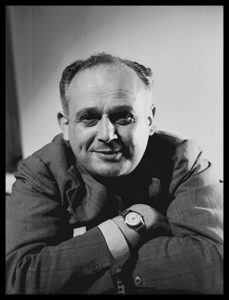
Moshe Pinhas Feldenkrais
Moshe Pinhas Feldenkrais was born on May 6, 1904 in Slavuta, in today’s Republic of Ukraine, he received an education in Hebrew language and Zionist philosophy. In 1918 Feldenkrais left alone for a six-month trip that took him to Palestine, where he worked as a laborer until 1923 when he enrolled in high school to obtain a diploma. During this time Feldenkrais developed his own self-defense techniques, learned Jujitsu and injured his knee in a football match. In 1930 Feldenkrais went to Paris and enrolled in the Faculty of Engineering, the École des Travaux publics de Paris, graduated in 1933 with specializations in mechanical and electrical engineering and began working as a research assistant while under Frédéric Joliot-Curie at the Radium Institute, while studying for his doctorate at the Sorbonne. From 1935 to 1937 he worked in the Arcueil-Cachan laboratories building a Van de Graaf generator, which was used for atomic fission experiments. In Paris in this period he met Jigaro Kano, founder of Judo and with his assistants he began his training in the practice of Judo receiving the black belt in 1936. From 1939-1940 he worked under Paul Langevin doing research on magnetism and ultra-sounds, then, when the Germans occupied Paris he was forced to flee to England where he was assigned, as a science officer of the British Admiralty, to conduct antisubmarine research in Scotland. While there, he taught Judo and self defense lessons. In 1942 he published a self-defense manual, Practical Unarmed Combat and Judo. The problems resulting from the knee injury, which had recurred during his escape from France, gave him no respite and Feldenkrais began to work on himself to deal with them.
In 1946 Feldenkrais left the Admiralty, moved to London and worked as an inventor and consultant in the private sector. He took judo lessons at London’s Budokwai, served on the international judo committee and scientifically analyzed the principles of judo. He published his first book on his Method, Body and Mature Behavior in 1949, and his last book on Judo, Higher Judo, in 1952. During his time in London he studied the work of George Gurdjieff, FM Alexander and William Bates, and went to Switzerland to study with Heinrich Jacoby.
In the early 1950s, Feldenkrais returned to Israel to head the electronics department of the Israeli army. Around 1954 he moved permanently to Tel Aviv and, for the first time, I started working using the method he developed,
also giving lectures to the Israeli Prime Minister, David ben Gurion, and starting the dissemination of the Method with the first teaching program for 12 students.
In the late 1950s, Feldenkrais presented his work in Europe and the United States. In the mid 60’s he released “Mind and Body” and “Bodily Expression”. In 1967, he published Improving the Ability to Perform, entitled Awareness through Movement in the 1972 English language edition.
In the late 1970s i ran a teacher training program in the United States in San Francisco. He published The Case of Nora in 1977 and The Elusive Obvious in 1981 and subsequently began a second Amherst training program, but was only able to teach the first two summers.After falling ill in fall 1981, he stopped teaching publicly . He died on July 1, 1984.